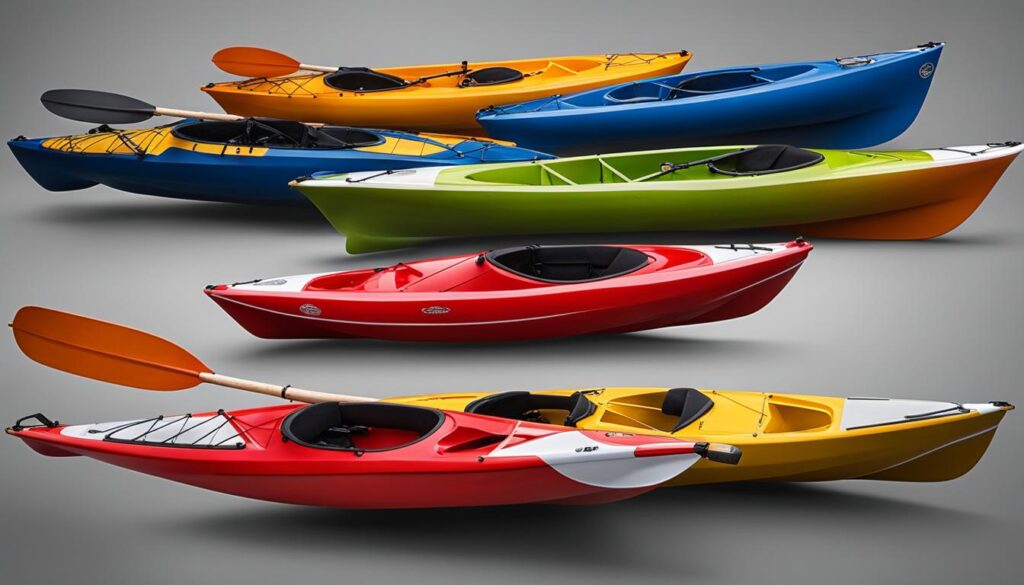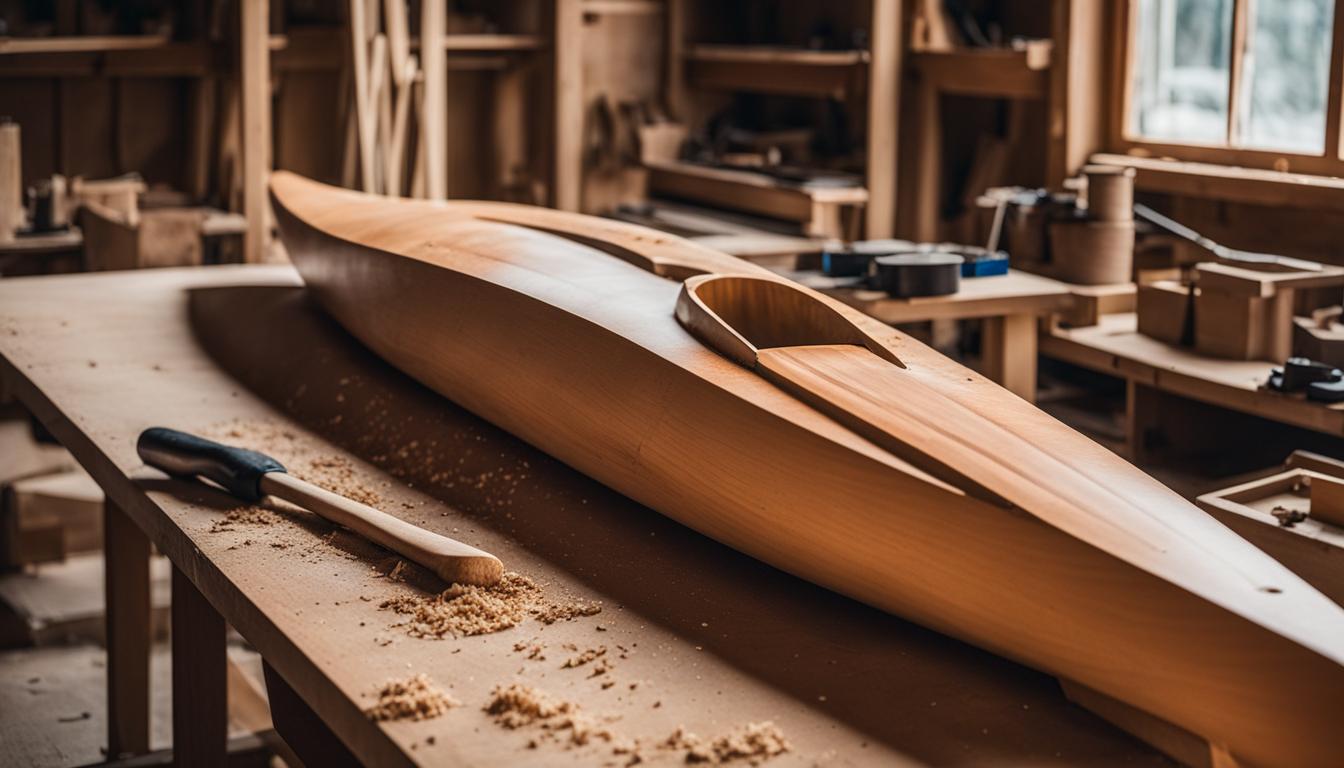Interested in kayaking but don’t have a lot of experience? Kayaking can be a great way to get out on the water, whether for a leisurely morning paddle or a more rigorous overnight adventure. In this section, we will provide our top tips for first-time kayak builders, including advice on choosing the right type of kayak, essential gear and equipment, and important safety considerations. Whether you’re starting a kayak building project from scratch or using a kit, these tips will help you confidently build your own seaworthy vessel and embark on your DIY adventure.
Key Takeaways:
- First-time kayak builders can confidently embark on their DIY adventure with the right tips and guidance.
- Choosing the right type of kayak is important based on personal preferences and intended use.
- Essential gear and equipment, such as a paddle, life vest, and bilge pump, ensure safety and enjoyment.
- Following proper techniques and safety guidelines is crucial for a successful kayak building project.
- Building your own kayak allows for customization and the creation of a reliable vessel.
Types of Kayaks for First-Time Builders
When it comes to building your first kayak, there are different types to consider. The two main types are sit-on-top and sit-inside kayaks. Sit-on-top kayaks are great for beginners as they are stable, easy to get in and out of, and suitable for warm water conditions. These kayaks have an open design with a molded seat on top, allowing for a more relaxed and comfortable paddling experience. They are also self-draining, making them ideal for recreational use.
Sit-inside kayaks, on the other hand, provide a more efficient paddling experience and are suitable for longer distances and colder water. These kayaks have an enclosed cockpit, providing better protection from the elements. They typically have a narrower design, allowing for faster speeds and improved maneuverability. Sit-inside kayaks are a popular choice for touring, sea kayaking, and whitewater paddling.
Additionally, first-time builders should also consider whether they want a single kayak or a double kayak, depending on their needs and preferences. Single kayaks are designed for solo paddlers and offer greater maneuverability and control. They are easier to transport and navigate in narrow or winding waterways. On the other hand, double kayaks, also known as tandem kayaks, can accommodate two paddlers and are perfect for couples, friends, or families who want to enjoy kayaking together. Double kayaks provide more stability and can carry more gear for extended trips.
Sit-on-top Kayaks vs Sit-inside Kayaks:
| Criteria | Sit-on-top Kayaks | Sit-inside Kayaks |
|---|---|---|
| Stability | High | Moderate to High |
| Maneuverability | Low to Moderate | High |
| Paddling Efficiency | Low | High |
| Protection from Elements | Low | High |
| Suitable Water Conditions | Warm | Warm to Cold |
| Noise Level | High (splashing water) | Low |

“Sit-on-top kayaks are known for their stability and ease of use, making them a popular choice for beginners. They are great for recreational paddling in calm waters and are suitable for warm weather conditions. On the other hand, sit-inside kayaks provide a more efficient paddling experience and better protection from the elements, making them suitable for longer distances and colder water. The choice between the two ultimately depends on the paddler’s preferences and the intended use of the kayak.” – Experienced Kayaker
Essential Gear and Equipment for First-Time Builders
Building your first kayak requires the right gear and equipment. To ensure a successful project and a safe kayaking experience, it’s important to have the following essentials:
- Kayak: Of course, you’ll need a kayak to build! Choose a design that suits your needs and skill level.
- Paddle: A reliable paddle is essential for maneuvering your kayak in the water.
- Life Vest: Safety should always come first. A properly fitting life vest will keep you afloat in case of an accident.
- Bilge Pump: This handy device helps remove any water that enters your kayak.
- Maps or Compasses: It’s important to have navigation tools to help you find your way on the water.
- Whistle or Signaling Device: In case of emergencies or to communicate with others, a whistle or signaling device is essential.
- Helmet or Hat: Protect your head from potential hazards with a helmet or hat.
- Water and Snacks: Stay hydrated and energized during your kayaking adventures.
In addition to these essentials, there are some optional items that you might find useful during your kayak building project and subsequent outings:
- Sunscreen
- Spare paddle
- Appropriate clothing for weather conditions
- Drybag with necessities
- Proper footwear
- River knife
- Kayak cart
By having all the necessary gear and equipment, you’ll be well-prepared for your first kayak building project and can enjoy a safe and enjoyable kayaking experience.
| Essential Gear | Optional Gear |
|---|---|
| Kayak | Sunscreen |
| Paddle | Spare paddle |
| Life Vest | Appropriate clothing for weather conditions |
| Bilge Pump | Drybag with necessities |
| Maps or Compasses | Proper footwear |
| Whistle or Signaling Device | River knife |
| Helmet or Hat | Kayak cart |
| Water and Snacks |
“Having the right gear not only enhances your kayaking experience, but it also ensures your safety on the water. Don’t forget to pack all the essentials and consider the optional items to make your kayak building project a success.” – Experienced Kayaker
Techniques and Safety Tips for First-Time Builders
Building your own kayak for the first time can be an exciting and rewarding endeavor. However, it’s important to follow proper techniques and safety guidelines to ensure a successful and safe construction process. Here are some valuable tips to consider when embarking on your first kayak building project:
Take your time and be meticulous
One of the most common mistakes first-time builders make is rushing through the construction process. Building a kayak requires precision and attention to detail. Take your time with each step, carefully following the instructions and double-checking measurements and alignments. Rushing can lead to costly mistakes or a kayak that isn’t properly balanced or aligned.
Seek guidance and learn from experienced builders
Learning to build a kayak can be a complex task, especially if you’re new to woodworking or boat construction. Don’t hesitate to seek guidance from experienced kayakers or join a kayak-building workshop in your area. Learning from those with hands-on experience can provide valuable insights, tips, and tricks that can help you avoid common pitfalls and ensure a successful build.
Focus on safety throughout the process
Safety should be a top priority when building your own kayak. Wear protective gear, such as safety glasses and gloves, to prevent injuries during the construction process. Additionally, work in a well-ventilated area to avoid inhaling hazardous fumes from adhesives and sealants. Keep your workspace organized, with tools and materials properly stored to prevent accidents and ensure a safe working environment.
Remember, building a kayak is not just about the end result – it’s also a journey of learning and discovery. Embrace the process, learn from any mistakes you make along the way, and enjoy the satisfaction of creating your own customized kayak.
By following these techniques and safety tips, you’ll be well on your way to successfully building your first kayak. Remember to take your time, seek guidance when needed, and prioritize safety throughout the process. With dedication and attention to detail, you’ll soon be paddling in your very own handcrafted kayak.
Conclusion
Building your own kayak can be an exciting and fulfilling endeavor, especially if you’re a novice looking to jump into the world of kayak construction. With the right guidance and tips, you can confidently embark on your DIY adventure. By following the top tips for novice kayak builders, you’ll be well-equipped to create your very own seaworthy vessel.
As a beginner, starting with the proper foundation is key. Choose the right type of kayak based on your preferences and needs. Whether you opt for a stable sit-on-top kayak or a more efficient sit-inside kayak, make sure it aligns with your desired paddling experience.
Gathering the essential gear and equipment is also crucial. From a reliable paddle and a comfortable life vest to practical items like maps and compasses, having the right tools will enhance your safety and enjoyment on the water. Don’t forget sunscreen and appropriate clothing, as they will protect you from the elements.
In your journey as a first-time builder, be sure to follow proper techniques and safety guidelines. Take your time with each step, seek guidance from experienced kayakers, and document your progress. By doing so, you’ll avoid common mistakes and ensure a successful kayak building project.
So, get ready to dive into the world of kayak construction and create a customized vessel that suits your style and needs. With the tips for novice kayak builders and the beginner’s guide to kayak construction, you’ll be well on your way to enjoying endless adventures on the water.
FAQ
What type of kayak should I choose for my first build?
It depends on your preferences and needs. Sit-on-top kayaks are great for beginners, as they are stable and easy to maneuver. Sit-inside kayaks provide a more efficient paddling experience and are suitable for longer distances. Consider your intended use and water conditions.
Should I build a single or double kayak?
The choice between a single or double kayak depends on your needs and preferences. Single kayaks are great for solo adventures, while double kayaks are perfect for paddling with a partner or bringing along extra gear.
What gear and equipment do I need to build a kayak?
Essential items include a kayak, paddle, life vest, bilge pump, maps or compasses, whistle or signaling device, helmet or hat, water, and snacks. Optional items you might need include sunscreen, spare paddle, appropriate clothing, drybag with necessities, proper footwear, river knife, and kayak cart.
Any tips for first-time kayak builders?
Take your time with each step, seek guidance from experienced kayakers or join a kayak-building workshop, double-check measurements and alignments, use proper adhesives and sealants, and document the process for future reference. Safety tips include wearing protective gear, using proper lifting techniques, working in a well-ventilated area, and keeping tools and materials organized to avoid accidents.
Is building my own kayak worth it?
Building your own kayak can be a rewarding and fulfilling experience. It allows you to customize your vessel and create a seaworthy, reliable boat. Plus, you’ll gain valuable knowledge about kayak construction that will come in handy for future projects.





